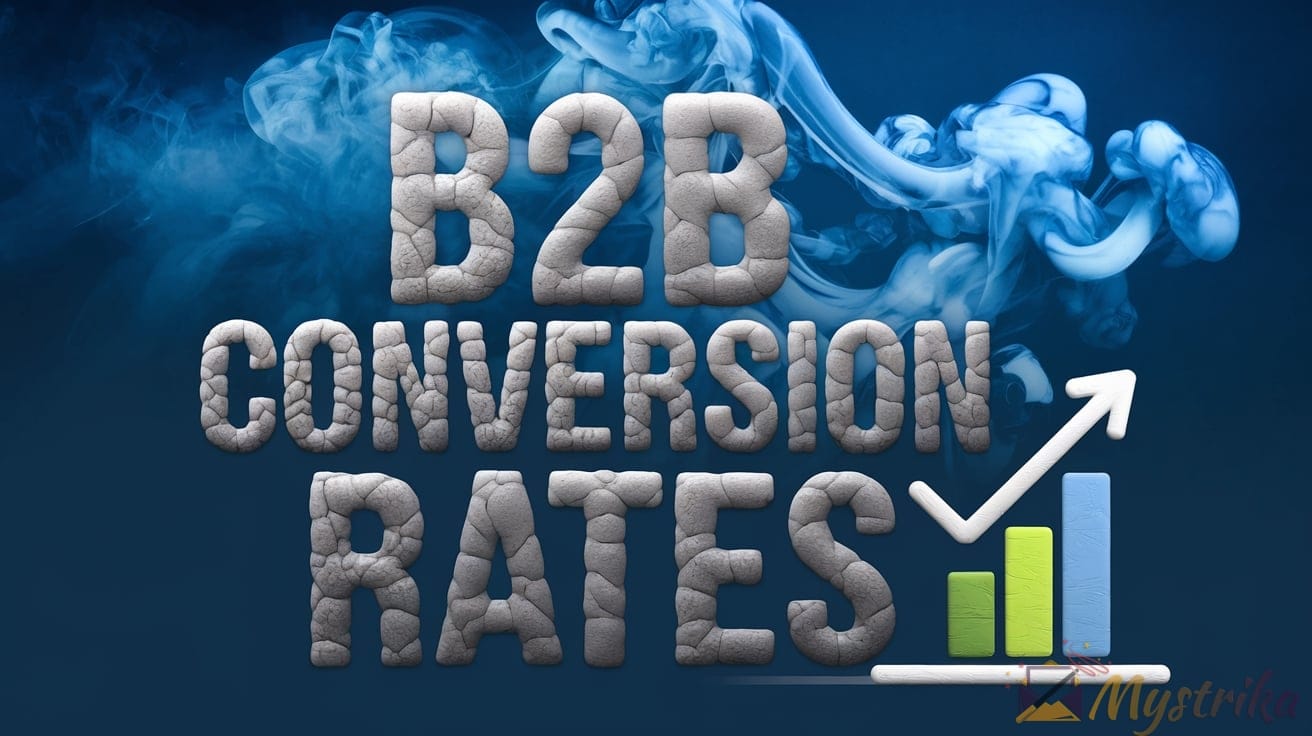In the world of B2B, converting clicks into customers is both an art and a science. While the average conversion rate hovers around 2-5%, savvy marketers use data, personalization, and optimization to shatter expectations. This guide reveals 6 proven tactics to accelerate your B2B conversions in 2025 and turn more of your hard-won traffic into sales.
Understanding B2B Conversion Rates and Goals
What exactly is a good conversion rate for a B2B company? It varies based on your industry, business model, and products. But in general, B2B conversion rates are lower than B2C ecommerce sites. While the average ecommerce conversion rate hovers around 2-3%, a good benchmark for B2B is between 2-5%.
However, once you understand the metrics and set the right goals, you can optimize your site to move the needle. Let’s break it down:
What is a good B2B conversion rate?
B2B buying cycles are longer and more complex. Multiple stakeholders are involved in big-ticket purchases. So if your site gets 2% of visitors to convert into leads or sales, that may be decent.
Here are some average B2B conversion rates by industry according to research by Unbounce:
- Software/SaaS – 5-7%
- IT Services – 4-6%
- Manufacturing – 3-5%
- Finance – 2-4%
- Healthcare – 4-6%
But a single metric doesn’t tell the full story. Your sales funnel metrics should align with conversion rate benchmarks for your industry. Analyze the full customer journey to identify weak spots.
Here are 5 key questions to understand your conversion health:
- What is the visitor to lead conversion rate?
- What is the lead to opportunity conversion rate?
- What is the opportunity to customer conversion rate?
- How long does your average sales cycle take?
- What is the lifetime value of a customer?
Crunching the numbers will give you clarity on what a “good” conversion rate means for your business.
Setting micro and macro conversion goals
The next step is to set micro and macro conversion goals that align with your funnel metrics.
Micro-conversions move visitors closer to becoming leads or customers. These include:
- Newsletter sign-ups
- Downloading assets like ebooks or whitepapers
- Watching product demo videos
- Clicking “Contact Sales” CTAs
Meanwhile, macro-conversions are major milestones:
- Filling out contact forms
- Signing up for a free trial
- Making a purchase
- Scheduling demos
Set a target for each based on your current baselines. Prioritize 1-2 micro and macro goals to focus your optimization efforts.
For example, you can aim to increase newsletter sign-ups by 10% or get 5% more visitors to click the Contact Sales CTA. Tracking micro-conversions will reveal bottlenecks before the final sale.
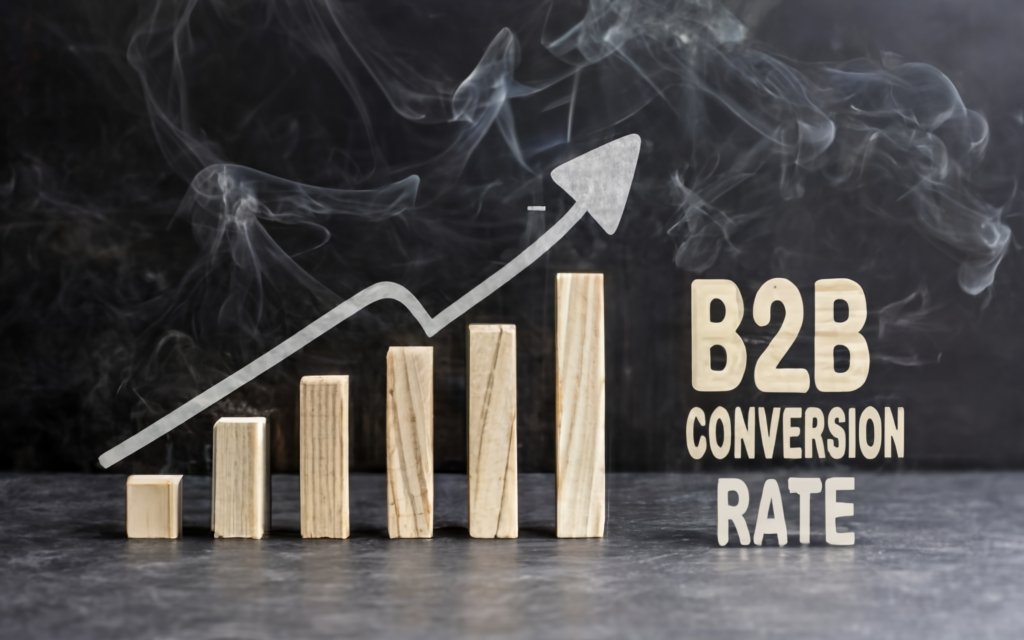
Optimizing Website Design and Navigation
Your website design and navigation has a direct impact on conversion rates. With a few tweaks, you can create a user-friendly experience that seamlessly guides visitors to take action.
Ensure mobile responsiveness
Here’s a sobering stat – more than 50% of B2B researchers use mobile devices daily. Yet many B2B sites aren’t mobile-friendly. Don’t let poor mobile UX cost you customers.
Start with the basics – make sure your site is responsive. Content should resize and rearrange seamlessly on smartphones and tablets. Check that:
- Text doesn’t become too tiny or overlap
- CTAs and buttons are visible and tappable
- Forms are easy to fill on smaller screens
- Product images and videos are responsive
Also, optimize page speed on mobile networks. Heavy desktop sites creep along on 3G/4G connections. Leverage accelerated mobile pages (AMP) or streamlined code to improve loading times.
Test your site on different devices to identify pain points. For example, navigation menus that work fine on desktop may be tedious on mobile. Simplify and adapt them for thumb-friendly access.
Mobile isn’t just for new customer acquisition. Reps use smartphones on the go to access collateral, pricing, inventory, and other tools. So both external- and internal-facing interfaces need optimization.
Streamline navigation and CTAs
Cluttered navigation is one of the biggest hurdles for B2B customers. They need to quickly find products, pricing, documentation, support pages, and other resources.
Here are 3 tips to streamline navigation for higher conversions:
- Cut down overstuffed menus. Limit primary navigation to 7 +/- 2 items. Group lesser-used pages under “Resources” or “Company”.
- Use descriptive menus and submenus. For example, instead of “Products”, list “All Products” under the main item.
- Make sure navigation links have clear CTAs that indicate what action they will take. For example, use “Contact Sales” instead of just “Contact”.
Also, place important CTAs strategically in the user journey. Don’t distract visitors with too many competing calls to action above the fold. Highlight one primary CTA based on where visitors are in the funnel.
Highlight security and trust symbols
Here’s the reality – 94% of B2B buyers say security is a major concern when choosing vendors. Reassure them by showcasing certifications like PCI compliance, SOC2, ISO etc. Display trust badges prominently on key pages.
B2B buyers also value social proof more than consumers do. Sprinkling customer logos, testimonials, case studies, and awards throughout the site builds credibility.
But avoid feature bloat. Cluttering pages with excessive badges and trust symbols can have the opposite effect. Selectively highlight the ones most valued by your audience. For example, government contractors may lean heavily on security certs.
Personalizing Content for Each Buyer Stage
B2B journeys aren’t linear. Leads interact with your brand across multiple touchpoints during their research process. Personalizing content to each stage can make the difference between losing a prospect and closing a deal.
Research personas and decision journeys
Avoid the “one-message-fits-all” approach. Not every lead is looking for the same information at the same time. Start by researching your audience personas and understanding their decision journeys.
Look at factors like:
- Demographics – industry, company size, role, etc.
- Motivations – primary pain points they want to solve
- Common objections – pricing concerns, feature needs, etc.
- Information needs – product specs, implementation details, security whitepapers, etc.
Map out the typical decision journey and key milestones for each persona. This will reveal the optimal content type and messaging for different stages.
For example, CIOs may focus heavily on security in the initial research phase. While CFOs want ROI proof when evaluating options.
Tailor content for awareness, consideration, decision stages
Armed with journey maps, adapt your content for each stage:
Awareness Stage:
- Blog Articles – Educate about key industry trends and challenges.
- eBooks – Provide actionable tips to get started.
- Video Testimonials – Build credibility.
Consideration Stage:
- Product Demo Videos – Showcase key features and differentiators.
- ROI Calculators – Help justify the investment.
- Analyst Reports – Lend 3rd party credibility.
Decision Stage:
- Case Studies – Prove you can solve their problems.
- Free Trials – Let leads experience your product.
- Pricing/Billing Details – Answer financial questions.
Of course, provide access to your full content library at every stage. But promote different assets based on what will advance leads in their journey.
Here are 3 ways to serve personalized content:
- Website Personalization – Display targeted content or CTAs based on persona and stage.
- Lead Scoring – Track engagement to determine content needs and sales readiness.
- Automated Journeys – Trigger relevant emails or web experiences for each milestone.
The more tailored the experience, the better. For example, “Get a custom ROI analysis” is more compelling than a generic calculator.
Help B2B leads move smoothly through complex decision journeys with the right content at the right time. They’ll convert faster when you “get them”.
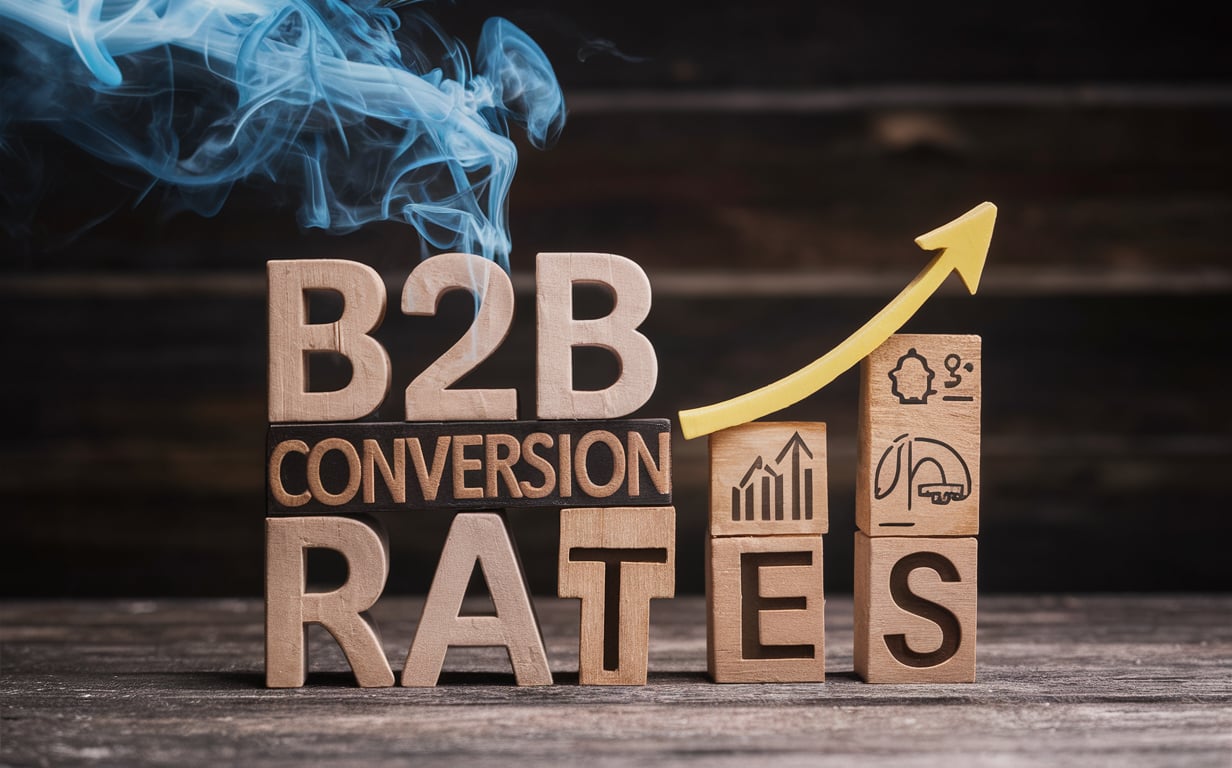
Improving On-Page SEO for Product and Content Pages
On-page optimization is table stakes for ranking high in search results. By optimizing product and content pages, you can align with SEO best practices while providing a better experience.
Optimize page speed and core web vitals
Slow page speed is an SEO killer. 53% of mobile site visits are abandoned if pages take over 3 seconds to load. It also hurts user experience and conversions.
Optimizing page speed should be an ongoing process. Regularly check metrics like:
- Time to First Byte – This measures how quickly a server responds to the initial request. Aim for under 1.3 seconds.
- First Contentful Paint – When users see the first output of painted content. Target under 1 second.
- Largest Contentful Paint – All content has loaded. Keep under 2.5 seconds.
- Cumulative Layout Shift – Abrupt visual changes as page loads. Minimize layout shifts.
- Total Blocking Time – Any moment the main thread is blocked from handling user input. Reduce blocking time.
Tackle speed bottlenecks like:
- Heavy images – Compress and lazy load them.
- Excessive redirects – Consolidate domains and pages.
- Bloated code – Minify CSS, JS, HTML files.
- Uncached assets – Configure proper caching.
- Overloaded servers – Scale up infrastructure.
Update meta titles and descriptions
Relevant, keyword-rich meta titles and descriptions increase click-through rates. Avoid duplicating or missing these critical tags.
For product pages, include keywords like product name, category, and key features. This helps searchers instantly know what the page is about.
For blogs and content, incorporate focus keywords, but keep descriptions >155 characters. Use compelling captions that drive clicks.
Include multimedia and structured data
Images, video, and other media enhance pages both for users and search engines. Supported file formats are crawled and indexable.
Optimize media with descriptive alt text and file names. Transcribe video and audio files for indexing.
Also markup content with schema.org structured data. This enables rich search features like product reviews, FAQs, ratings, etc.
Building Trust with Social Proof and Testimonials
Social proof is crucial in B2B buying decisions. Case studies, testimonials, reviews and ratings inspire trust at every stage of the customer journey. Leverage them across touchpoints to drive conversions.
Curate customer case studies and testimonials
Case studies and testimonials directly from your successful customers provide powerful validation. But avoid stale, generic examples. Craft compelling stories that connect with your audience.
For best results, cover:
- Company overview – Let readers relate to the customer.
- Challenges – Describe key struggles they wanted to solve. These should align with target buyer pain points.
- Solutions – Explain how your product or service solved these challenges. Focus on outcomes, not features.
- Results – Quantify ROI, productivity gains, cost savings, or other measurable benefits. Use charts for data-driven proof.
Curate a portfolio spanning your products, industries, and use cases. Then feature different case studies on high-value pages:
- Product pages – Showcase a customer with a similar use case.
- Blog posts – Choose studies that support the topic.
- Landing pages – Match case studies to campaign offers.
- Pricing pages – Provide examples across every tier.
Also, don’t overlook text or video testimonials. First-person stories resonate strongly when prospects hear directly from people like them.
Display reviews and ratings prominently
Positive ratings and reviews should be front-and-center. Feature them across your site, especially on high-intent pages.
For example, showcase ratings in product descriptions, buying guides, and comparisons. Pull in latest and most favorably rated reviews.
Reviews influence 90% of B2B buying decisions. Yet only 23% of companies actively collect and showcase reviews online. Stand out by making them easily accessible.
Customers also value seeing consistent ratings across third-party review sites. So monitor and actively collect reviews on sources like G2, Capterra, and TrustRadius. Then share the love by showcasing everywhere you can.
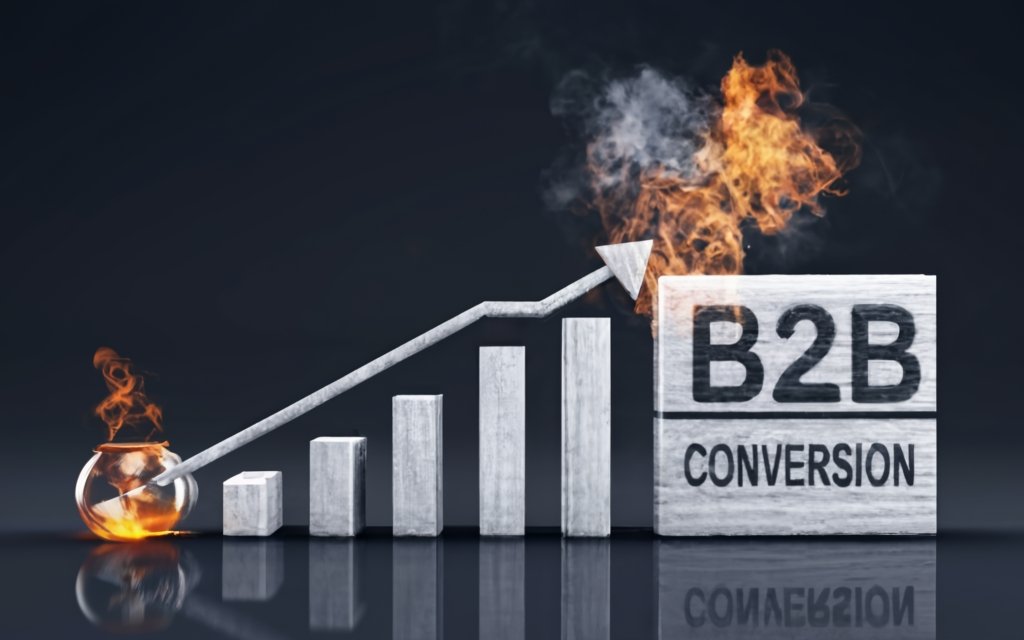
Retargeting Abandoned Carts with Personalized Emails
Abandoned carts are a missed opportunity in B2B ecommerce. But with timely and relevant follow-up messages, you can recover lost sales.
According to SaleCycle, cart abandonment rates average 65% for B2B. Yet fewer than 20% of businesses proactively win back abandoned cart customers. Don’t let revenue leak out. With the right follow-up strategy, you can boost conversion rates by 10-15%.
Send timely and personalized follow-ups
Speed and relevance are key to bringing shoppers back. Segment users and set up automated flows to deliver timely, personalized messages.
Send the first follow-up within 15 minutes for the best open and recovery rates. Highlight they left items behind and make it easy to resume their order.
Then 2-3 reminder emails over the next week help recapture more customers. Remind them what they wanted and share new incentives to complete the purchase.
Personalize messages with:
- Abandoned product details – Include product images, SKUs, pricing etc. This adds context.
- Dynamic offers – Provide exclusive discounts or bonuses based on cart value.
- Buyer history – Reference previous purchases or site behavior to demonstrate familiarity.
- Segmented pricing – If they saw a quote, remind them of their quoted rate.
Highlight unique product value in copy
Email copy should quickly re-engage the customer and focus on product value. For example:
“Don’t miss out on the 45-day free trial of [product name] that helps service teams resolve tickets 32% faster.”
Remind them of key features or capabilities that attracted them initially. Also, incorporate any content they engaged with while browsing. This shows you understand where they are in the buyer’s journey.
Offer special incentives to complete purchase
Sweetening the deal with time-bound promotions encourages prompt action. Some ideas:
- Discounts – Percent or dollar-value coupons applied to their cart.
- Free trials – Extra trial period beyond your normal policy.
- Free shipping – Waive normal shipping costs.
- Bonus products/services – Add a gift alongside their purchase.
- Expedited delivery – Offer overnight or same-day shipping.
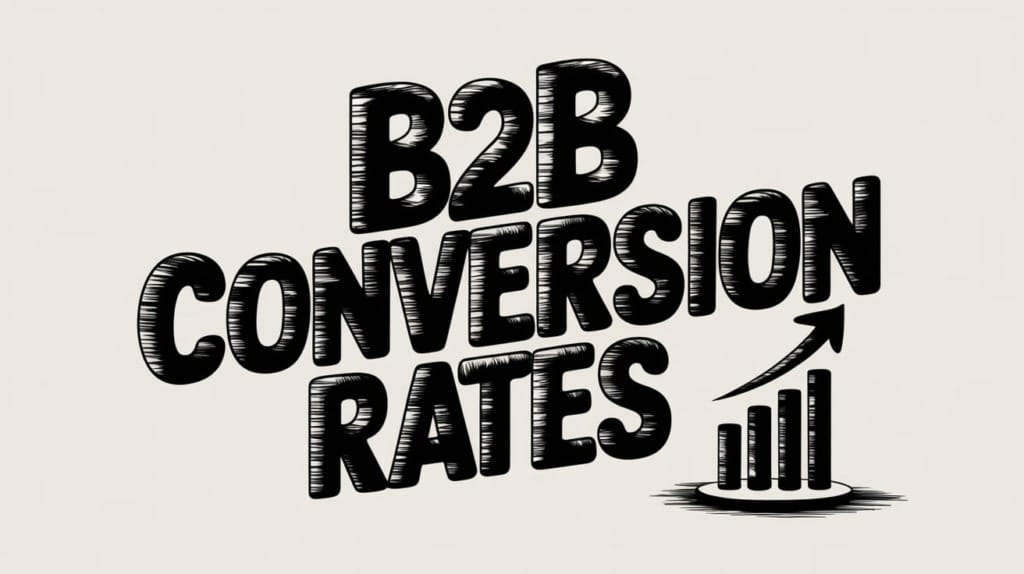
Key Takeaways
Optimizing your B2B conversion rates takes work, but pays off exponentially in revenue and customer growth. Here are the key lessons to drive higher conversions:
- Set micro and macro conversion goals that align to your sales funnel. Tracking both will reveal optimization opportunities at every stage.
- Optimize site speed and navigation through speed testing, streamlined menus, and clear CTAs. Frictionless experiences convert.
- Personalize content to buyer personas and stages. Serving targeted content accelerates journeys and builds trust.
- Improve on-page SEO with optimized meta titles and descriptions, along with fast load times. This increases organic visibility and clicks.
- Feature social proof like customer testimonials, case studies, and reviews. Peer experiences provide credibility to drive conversions.
- Retarget abandoned carts with timely, relevant follow-up messages and special incentives. Proactive outreach recovers lost revenue.
- Continuously test and iterate your pages, content, offers, and journeys. Optimization is an ongoing process, not a one-time project.
With the right strategy tailored to your B2B business, you can lift conversion rates and get exponentially higher returns from your marketing and sales efforts.
Frequently Asked Questions
Q: What is a good conversion rate for B2B websites?
A: Average B2B website conversion rates range from 2-5%, with SaaS and software sites on the higher end. Rates vary widely by industry, so focus on your own sales funnel metrics.
Q: How do you calculate conversion rate?
A: Conversion rate is calculated by dividing the number of conversions by the total number of website visitors over a given time period. Identify your key conversions first, whether that’s demo sign-ups, contact form submissions, purchases etc.
Q: Why are B2B conversion rates lower than B2C ecommerce?
A: B2B buyers make larger, complex decisions over longer periods. Multiple people are involved in big-ticket purchases. Longer sales cycles with more consideration touchpoints lead to lower website conversion rates.
Q: How can you improve time on site and lower bounce rates?
A: Engaging content, clear navigation, trust signals, and seamless user experience will improve time on site. Address slow page speeds, prominent CTAs, personalized content, and fixing technical errors to reduce bounce rates.
Q: What are micro-conversions and why do they matter?
A: Micro-conversions are small actions that move visitors closer to a final conversion, like downloading assets, watching videos, or clicking CTAs. Tracking these can help optimize each buyer journey stage.
Q: How can you personalize landing pages and content?
A: Web personalization tools, lead scoring, and marketing automation help tailor landing page content and messaging to different segments and buyer journey stages.
Q: What incentives help recover abandoned shopping carts?
A: Timely follow-up and special offers like discounts, free gifts, free shipping, extended trials etc. can incentivize cart abandoners to complete their purchase.

